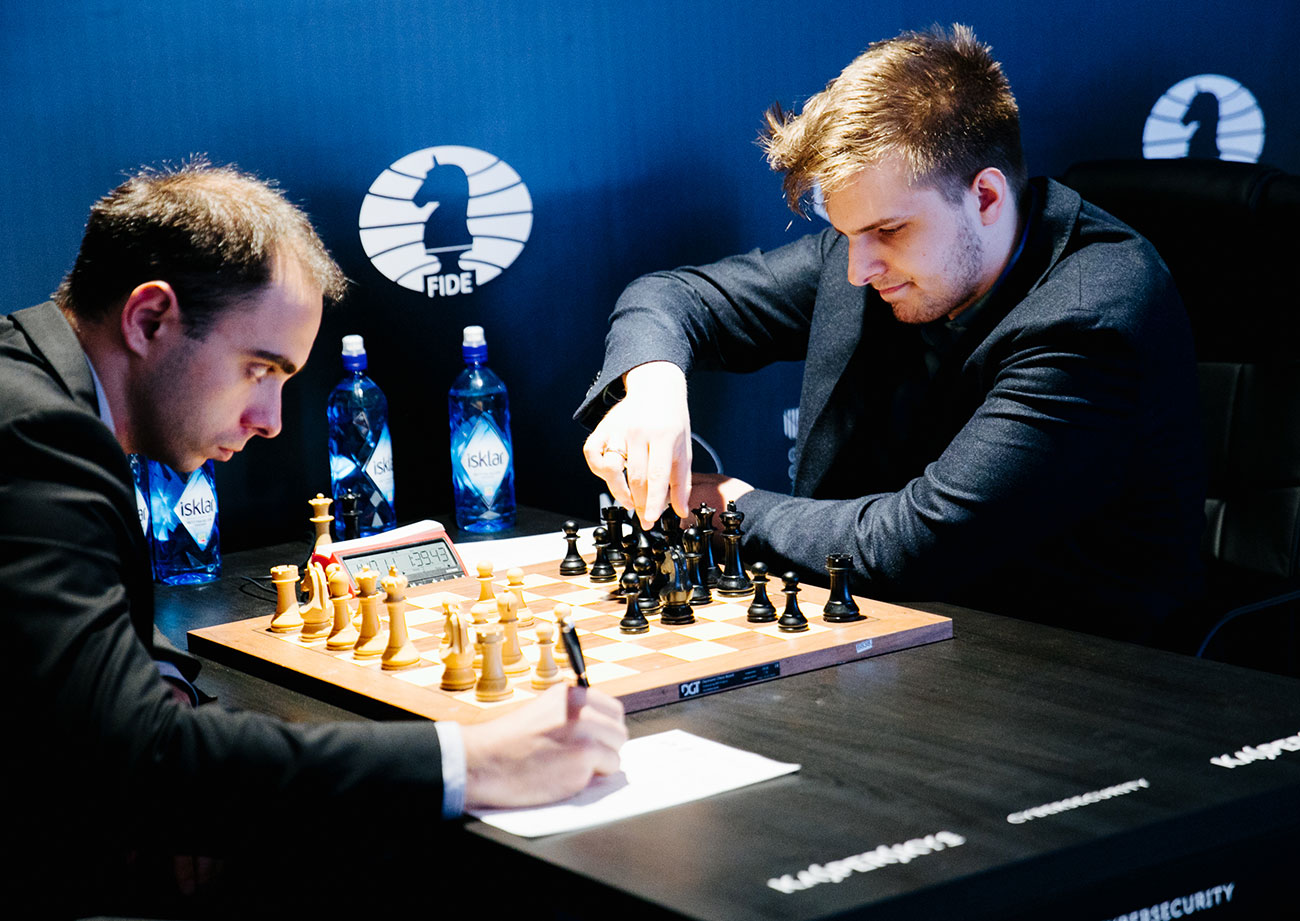Round six
Levon Aronian has been the star of the tournament so far, enjoying a second-wind in his career the likes of which have his colleagues in a deep state of envy. Not only has he won a slew of major tournaments, including the recent World Cup, but his actual play and preparation have been peerless, yielding him scalps of every top player in the world, including the World Champion.
Results

Levon Aronian nearly pulled it off against Peter Svidler | Photo: Valerij Belobeev
In round six, he faced Peter Svidler with white, and as he had notched wins in all his previous whites, it made sense to expect a repeat performance here. In fact, it came very close as he once again showed top preparation and built a significant edge against the many-times Russian champion.
Levon Aronian ½-½ Peter Svidler

[Event "FIDE Grand Prix Palma 2017"] [Site "Palma de Mallorca ESP"] [Date "2017.11.22"] [Round "6"] [White "Aronian, Levon"] [Black "Svidler, Peter"] [Result "1/2-1/2"] [ECO "E80"] [WhiteElo "2801"] [BlackElo "2763"] [Annotator "A. Silver"] [PlyCount "48"] [EventDate "2017.??.??"] 1. d4 Nf6 2. c4 g6 3. f3 c5 4. d5 Bg7 5. e4 d6 6. Nc3 e6 7. Nge2 exd5 8. cxd5 a6 9. a4 Nbd7 10. Ng3 Nh5 11. Nxh5 gxh5 12. Bd3 $146 {Black's counter play pretty much revolves around a ...b5 or ...f5 breakthrough, and since White's light-squared bishop is the definition of a bad bishop, on d3 it prepares to exchage itself in the event of ...f5.} ({Previously known was} 12. Be2 Bd4 13. Bf4 Rg8 14. g3 Ne5 15. Qd2 Bh3 16. Bxe5 dxe5 {1/2-1/2 (40) Vitiugov,N (2721) -Grischuk,A (2752) Novosibirsk 2016}) 12... O-O 13. O-O f5 14. exf5 Ne5 15. Bc2 Bxf5 16. Bxf5 Rxf5 17. Ne4 c4 18. Qc2 Qb6+ $2 ({The logical} 18... b5 {was the principled continuation.}) 19. Kh1 $16 Rff8 20. Ng5 $2 {A mistake that throws away White's advantage, After the game, Aronian admitted he was disappointed to have played this, and that before the mistake he had been playing quickly and well, and here had spent 25 minutes to unleash this howler.} (20. Bg5 $16 { was the correct continuation as pointed out by Aronian and the engines.}) 20... Nd3 $11 21. Ne6 Rae8 22. Nxg7 Nf2+ 23. Kg1 Nd3+ 24. Kh1 Nf2+ 1/2-1/2
The topic of this 60 minute video clip is the major idea of the 8.h3 0-0 9.Bd3 line. It has not won much love among defenders of the Benoni - White players are coming dangerously close to realising the dream of squeezing the opponent.
The most dramatic result was that by Evgeny Tomashevsky and Teimour Radjabov. Tomashevsky had not been the most ambitious player in Palma de Mallorca thus far, showing a slight aversion to confrontations or long fights. However, Teimour Radjabov, who had been hot and cold (mostly hot with black and his King’s Indian) had been having an uneven event. Declining the offer to face Radjabov’s King’s Indian (understandably), Tomashevsky veered the helm to 1.e4 waters and a Classical Pirc was the result. It was a balanced game until move 20 or so, when a repetition was visible on the board. The Azeri player declined, preferring to fight on, but was not rewarded for his tenacity and went under.
Evgeny Tomashevsky 1-0 Teimour Radjabov (annotations by GM Elshan Moradiabadi)
The resulting positions are usually dynamic or double-edged and offer fairly balanced chances. The better tactician may win, but do not be dissappointed if the game ends in a spectacular and logical draw!
Naturally, Radjabov’s willingness to fight on was admirable, but his loss could not come at a worse time. He most likely needs at least +2 to make the Candidates, and after his loss now is at -1. That means that three wins are needed, and even then it may need a prayer too.
Two more decisive games were signed in round six: Gelfand’s loss to Inarkiev, and Riazantsev’s loss to Rapport. It has not been a good event for the great Israeli player, and this game was no exception. On the other hand. The game between Riazantsev and Richard Rapport was exactly what one expected of them: a bare-knuckled brawl that swung both ways before finally favoring Rapport for good.

Riazantsev was unable to keep pace with Rapport when all hell broke loose on the board | Photo: Valerij Belobeev
Alexander Riazantsev 0-1 Richard Rapport (annotations by GM Elshan Moradiabadi)
Many times when a top player blunders, it is routinely described by the esoteric term „chess blindness.“ In the series What Grandmasters Don‘t See, chess trainer and world-class commentator Maurice Ashley strips away the myth, and for the first time explains why the root of these mistakes is more often based on the psychology of human learning.
In Volume 1 of the series, Ashley coins a new term Protected Squares, and shows how many errors occur on squares that seem invulnerable because they are clearly guarded by pawns.

Anish Giri and Dmitri Jakovenko played a strange draw, which went for 36 moves yet left all 16 pawns still on the board | Photo: Valerij Belobeev
Levon Aronian leads the event with 4.0/6, but no fewer than nine players stand at 3½/6. There are three rounds to go, and nothing is even remotely decided. The final curve before the sprint to the end lies ahead, and bloody chess is on the menu. Heads will roll, count on it.
Standings after six rounds
| 1 |
1 |
|
GM |
Aronian Levon |
|
2801 |
4,0 |
| 2 |
2 |
|
GM |
Vachier-Lagrave Maxime |
|
2796 |
3,5 |
| |
3 |
|
GM |
Nakamura Hikaru |
|
2780 |
3,5 |
| |
4 |
|
GM |
Ding Liren |
|
2774 |
3,5 |
| |
5 |
|
GM |
Svidler Peter |
|
2763 |
3,5 |
| |
9 |
|
GM |
Harikrishna P. |
|
2738 |
3,5 |
| |
10 |
|
GM |
Jakovenko Dmitry |
|
2721 |
3,5 |
| |
14 |
|
GM |
Tomashevsky Evgeny |
|
2702 |
3,5 |
| |
15 |
|
GM |
Rapport Richard |
|
2692 |
3,5 |
| 10 |
6 |
|
GM |
Giri Anish |
|
2762 |
3,0 |
| |
16 |
|
GM |
Inarkiev Ernesto |
|
2683 |
3,0 |
| 12 |
7 |
|
GM |
Li Chao B |
|
2741 |
2,5 |
| |
8 |
|
GM |
Radjabov Teimour |
|
2741 |
2,5 |
| |
12 |
|
GM |
Eljanov Pavel |
|
2707 |
2,5 |
| |
13 |
|
GM |
Vallejo Pons Francisco |
|
2705 |
2,5 |
| |
17 |
|
GM |
Riazantsev Alexander |
|
2651 |
2,5 |
| 17 |
18 |
|
GM |
Hammer Jon Ludvig |
|
2629 |
2,0 |
| 18 |
11 |
|
GM |
Gelfand Boris |
|
2719 |
1,5 |
All Round 6 games
Links



























